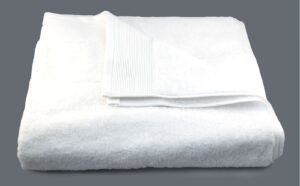How Often Should You Change Your Bath Towel? Every 3-4 days
You should typically aim to change your bath towel once every three to four days.
Bath towels soak up water and dead skin cells after a shower and can become a breeding ground for bacteria, mold, and yeast.
They can also get a musty smell if they are not dried properly. Therefore, it is recommended to change your bath towel every three to four days to maintain personal hygiene.
Regular washing and changing of bath towels is crucial for maintaining personal hygiene. The damp and warm environment of a used towel is a perfect breeding ground for various germs and molds.
Therefore, switching your towel every three to four days can help keep these unwanted bacteria at bay and ensure your post-shower routine is as clean as can be.

Key Takeaway
The Importance Of Clean Towels
Clean towels are vital for maintaining personal hygiene. It is recommended to change your bath towel every three to four uses, ensuring a fresh and bacteria-free experience.
The Role Of Bath Towels In Maintaining Hygiene
- A bath towel is an essential part of our daily personal hygiene routine, helping us to dry off after a shower or bath.
- It not only keeps us clean and fresh but also plays a vital role in maintaining overall hygiene.
How Towels Can Harbor Bacteria And Germs?
Bath towels provide the perfect environment for bacteria and germs to thrive due to their moisture-retaining nature.
Here are some key points to consider:
- Moisture: When we use towels, they absorb moisture from our bodies, creating a damp environment ideal for bacterial growth.
- Skin cells: Dead skin cells can accumulate on towels, providing a food source for bacteria.
- Personal care products: Residual lotions, oils, and cleansers may also be present on towels, further promoting bacterial growth.
The Impact Of Dirty Towels On Skin Health
Using dirty towels can have severe consequences on our skin health.
Here’s what you need to know:
- Bacterial infections: Dirty towels can harbor harmful bacteria that may cause skin infections, such as folliculitis or impetigo.
- Acne breakouts: Bacteria and oils accumulated on towels can clog pores and lead to acne breakouts.
- Irritation and allergies: Residues from detergents or other cleaning products left on towels can irritate the skin and even trigger allergies.
Remember, maintaining clean towels is crucial for good hygiene and overall skin health. Regularly washing and replacing towels is essential to minimize the risk of bacterial contamination and ensure their effectiveness in keeping you clean and fresh.
Factors Influencing Towel Changing Frequency
Towel changing frequency depends on factors such as personal hygiene, frequency of use, and towel quality.
Regular towel changes, at least every 3-4 uses, help maintain cleanliness and prevent bacterial growth.
To determine how frequently you should change your bath towel, there are several factors to consider. These factors include the frequency of towel usage, personal hygiene habits, environmental conditions, and the towel material and quality.
Let’s explore each of these factors in detail:
Frequency Of Towel Usage
- How often you use your bath towel plays a significant role in determining how frequently it should be changed.
- The more frequently you use your towel, the more quickly it can become dirty and accumulate bacteria.
- It is recommended to wash your towel every two to three uses if you use it daily.
Personal Hygiene Habits
- Personal hygiene habits can also impact how often you should change your bath towel.
- If you are diligent about your personal hygiene, such as showering daily and using soap effectively, your towel may require less frequent changing.
- However, if you have specific skin conditions or are prone to excessive sweating, changing your towel more frequently is advisable.
Environmental Conditions
- The environmental conditions in which you use your towel can affect its cleanliness and smell.
- In humid or damp environments, towels tend to dry slower, creating an ideal breeding ground for bacteria.
- If you live in a humid climate or have poor ventilation in your bathroom, it is recommended to change your towel more frequently.
Towel Material And Quality
- The material and quality of your bath towel can influence how often you need to change it.
- Towels made from natural fibers like cotton tend to absorb moisture better but may require more frequent changing due to potential bacteria growth.
- Towels with antimicrobial properties or those made from quick-drying synthetic materials may reduce the need for frequent towel changes.
Considering all these factors, it is generally recommended to change your bath towel every three to four days, especially if you use it daily.
However, personal preferences may vary, and it is essential to assess the cleanliness and smell of your towel regularly to determine if it needs more frequent changing.
Ultimately, maintaining good hygiene practices will ensure your towel remains clean and fresh for every use.
Indicators For Towel Replacement
Wondering how often to change your bath towel? Look for indicators like a musty smell or dampness that doesn’t go away after drying.
To maintain hygiene, it’s recommended to replace your towel every 2-3 days to prevent bacterial growth.
Foul Odor Or Mustiness
Bath towels that emit a foul odor or have a lingering musty smell are definite indicators that it’s time for a replacement.
Here are some reasons why your towel may have a less-than-pleasant scent:
- Bacteria buildup: Over time, bacteria can accumulate on your towel, especially if it remains damp for extended periods. This can result in an unpleasant odor.
- Mold or mildew growth: If you hang your towel in a poorly ventilated area, mold or mildew can develop, leading to a musty smell.
- Inadequate drying: Insufficient drying can leave your towel damp, creating an ideal environment for odor-causing bacteria.
- Product buildup: Excessive use of fabric softeners or cosmetic products can leave residue on your towel, leading to a foul smell.
Visible Stains Or Discoloration
Stains and discoloration on your bath towel can not only be unsightly but also a sign that it’s time to replace it.
Here are a few reasons why stains and discoloration may occur:
- Bleach or chemical reactions: Accidental contact with bleach or certain chemicals can cause color fading or a discolored appearance on your towel.
- Personal care products: Frequent use of products like makeup, hair dyes, or self-tanners can result in stains that are difficult to remove.
- Food and beverage spills: Accidental spills of food or drinks can leave stubborn stains on your towel that may not come out even after washing.
Loss Of Absorbency
The primary function of a bath towel is to absorb moisture effectively. If your towel is no longer doing its job efficiently, it’s time for a replacement.
Here are a few factors that can contribute to a loss of absorbency:
- Overuse: Frequent use and washing can cause the fibers in your towel to become worn out, reducing its ability to absorb moisture.
- Fabric deterioration: Low-quality towels or continuous exposure to harsh detergents can damage the fabric, leading to decreased absorbency.
- Hard water deposits: If you live in an area with hard water, mineral deposits can accumulate on your towel over time, hindering its ability to absorb water effectively.
Signs Of Wear And Tear
Towels go through regular wear and tear due to everyday use.
Here are some common signs that indicate your bath towel may need replacing soon:
- Frayed edges: If you notice fraying along the edges of your towel, it’s a clear sign of deterioration and a signal that a replacement is in order.
- Threadbare or thin areas: As your towel ages, certain areas may become thinner or even develop small holes, making it less effective at drying.
- Loose or pulled threads: Over time, threads can become loose or snagged, compromising the overall quality and durability of your towel.
- Lack of fluffiness: A towel that no longer feels soft and plush might indicate that the fabric has worn down, reducing its effectiveness and comfort.
Remember, keeping your bath towel clean and fresh is essential for personal hygiene. By paying attention to these indicators, you can ensure that you have a towel that performs optimally, providing you with the comfort and functionality you deserve.
Establishing A Towel Changing Routine
Establishing a towel changing routine is crucial for maintaining hygiene. Discover the optimum frequency for changing your bath towel to ensure cleanliness and freshness.
Maintaining a proper routine for changing your bath towels not only ensures good hygiene but also prolongs the lifespan of your towels.
We will explore the recommendations from experts and dermatologists, considerations for households with different members, and tips for proper towel care and maintenance.
Recommendations From Experts And Dermatologists:
- It is generally recommended to change your bath towel every three to four days.
- If you have sensitive skin or any skin conditions such as acne or eczema, it is advisable to use a fresh towel every day.
- Experts suggest using a separate face towel to prevent the transfer of bacteria from your hands or body to your face.
Considerations For Households With Different Members:
- For households with children, it is recommended to change their towels more frequently, preferably every day or every other day, as they tend to have more contact with dirt and germs.
- If someone in your household is sick or has a contagious condition, it is crucial to provide them with their own towel and change it daily to minimize the risk of spreading infection.
- Individuals who frequently sweat or engage in intense physical activities may need to change their towels more frequently to maintain hygiene and prevent odors.
Tips For Proper Towel Care And Maintenance:
- Hang your towel to dry after each use to prevent the growth of bacteria and mildew. Ensure good airflow by spreading it out instead of bunching it up.
- Avoid sharing towels with others to minimize the transfer of bacteria and germs.
- Wash your bath towels regularly, at least once a week, using hot water and a suitable detergent. This helps remove any dirt, body oils, and bacteria that may accumulate over time.
- Avoid using fabric softeners or dryer sheets as they can reduce the absorbency of the towel. Instead, opt for vinegar or baking soda to soften and freshen your towels during the wash.
- Check the care instructions provided by the manufacturer to ensure proper washing and drying temperatures specific to your towels.
By establishing a towel changing routine and following these recommendations and tips, you can maintain hygiene and ensure the longevity of your bath towels. Remember, regular towel care is essential for a clean and pleasant bathing experience.
Extending Towel Lifespan
Changing your bath towel regularly is essential to maintain hygiene and prevent bacterial growth. By extending the lifespan of your towel, you can save money and contribute to a more sustainable environment.
When it comes to bath towels, extending their lifespan not only saves you money but also helps reduce waste.
Implementing a few simple strategies can help prevent bacterial growth, ensure effective towel drying, and even find alternate uses for towels to minimize wear and tear.
Check out the following tips to make the most of your bath towels:
Strategies For Preventing Bacterial Growth:
- Wash your towel regularly: Regular washing prevents the buildup of bacteria, oils, and dead skin cells that can lead to unpleasant odors and decreased absorbency.
- Hang towels to dry: After use, hang your towel in a well-ventilated area to allow it to dry completely. This helps prevent the growth of mold and mildew.
- Avoid sharing towels: Sharing towels increases the risk of transferring bacteria and germs. Each person in your household should have their own designated towel.
- Skip fabric softeners: Fabric softeners can leave a residue on towels, affecting their absorbency. Instead, opt for vinegar or baking soda as a natural alternative during the wash cycle.
- Consider antimicrobial towels: Investing in towels with antimicrobial properties can help inhibit the growth of bacteria and keep them fresh for longer periods.
Guidance On Effective Towel Drying Techniques:
- Pat, don’t rub: When drying your body with a towel, gently pat your skin instead of rubbing vigorously. This reduces friction on the towel fibers and helps maintain their softness and absorbency.
- Use separate towels for face and body: Using a separate towel for your face and body helps prevent the transfer of bacteria and oils that can cause acne and other skin issues.
- Allow towels to fully dry between use: It’s important to allow your towel to dry completely between uses. Avoid folding damp towels and leaving them in a pile, as this can lead to mildew growth and musty odors.
Alternate Uses For Towels To Reduce Wear And Tear:
- Beach or picnic blanket: Large bath towels can serve as a comfortable beach or picnic blanket, protecting you from the sand or grass.
- Pet towel: Keep a designated towel for drying off your furry friend after a bath or a walk in the rain. This helps keep your regular bath towels free from excess pet hair and dirt.
- Yoga or exercise mat: Placing a towel over your yoga mat or workout surface can provide extra grip and comfort during your exercise routine.
By implementing these strategies for preventing bacterial growth, following effective towel drying techniques, and discovering alternative uses for towels, you can extend their lifespan and enjoy their freshness and functionality for a longer period.
So go ahead, make the most out of your bath towels while reducing waste and ensuring optimal hygiene.
Environmental Impact and Sustainability
In today’s world, where environmental consciousness is on the rise, it’s crucial to consider the ecological footprint of our daily habits, including the seemingly mundane act of changing towels.
Here, we delve into the environmental impact of frequent towel changes and explore sustainable practices to minimize our ecological footprint.
Environmental Impact of Frequent Towel Changes
- Resource Depletion: The production of towels involves significant use of water, energy, and raw materials. Frequent replacement exacerbates resource depletion concerns.
- Manufacturing Emissions: Towel production contributes to carbon emissions, with manufacturing processes releasing greenhouse gases into the atmosphere.
- Waste Generation: Discarded towels contribute to landfill waste, adding to the global waste management challenge.
Sustainable Practices in Towel Usage
- Extended Use: Encouraging users to extend the lifespan of towels by using them for a longer duration before replacement.
- Proper Drying: Emphasizing the importance of thorough drying to prevent odors and bacterial growth, thus reducing the need for frequent washing.
- Spot Cleaning: Advising users to spot clean towels when possible instead of washing the entire towel after each use.
Sustainable Disposal Methods
- Recycling Initiatives: Promoting the recycling of old towels to reduce landfill waste. Towels can be repurposed into cleaning rags or donated to animal shelters.
- Biodegradable Options: Exploring biodegradable towels that break down more easily, minimizing their environmental impact.
Encouraging the Use of Eco-Friendly Towel Materials
- Organic Cotton: Advocating for the use of organic cotton towels, which are produced without harmful pesticides and chemicals, reducing environmental impact.
- Bamboo Towels: Introducing the concept of bamboo towels, known for their rapid growth and minimal environmental impact compared to traditional cotton.
Consumer Awareness and Responsibility
- Education: Empowering consumers with knowledge about the environmental impact of their choices in towel usage.
- Responsibility: Encouraging consumers to make mindful decisions, considering the lifecycle of the products they use.
Adopting sustainable practices in towel usage not only benefits the environment but also promotes a responsible and eco-conscious lifestyle.
By making informed choices in towel selection, usage, and disposal, individuals can contribute to a more sustainable and environmentally friendly world.
Conclusion
To ensure optimal hygiene and freshness, it is recommended to change your bath towel every three to four days.
Bath towels are breeding grounds for bacteria, dirt, and moisture, which can lead to unfavorable odors and potential skin issues. Regular washing helps maintain towel durability and prevent bacterial buildup.
It is crucial to follow proper towel care practices, such as hanging them to dry properly and washing them with hot water and detergent.
Neglecting to change towels frequently can compromise their effectiveness and leave you feeling less clean after each use.
By adhering to a consistent towel-changing routine, you can enhance personal hygiene and enjoy the refreshing feeling of a clean damp cloth after every shower.
Prioritize your well-being by making towel maintenance a part of your regular self-care routine. Trust us, your skin will thank you!






